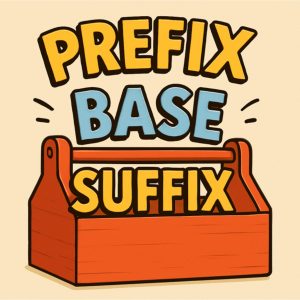10 Vocabulary/Morphology – Prefixes
Category: Vocabulary
Concept: Prefixes
Connections to The Ontario Curriculum, Grades 1-8: Language (2023):
_____B2 Language Foundations for Reading and Writing
_________B2.1 Word-Level Reading and Spelling: Using Morphological Knowledge
_________B2.2 Vocabulary
Prior Knowledge:
- Understanding that base words can have prefixes added to them
- Understanding that prefixes can change the meaning of a base word
What’s the definition?
The following terms from the The Ontario Curriculum, Grades 1-8: Language (2023) glossary pertain to the concepts underlying prefixes:
Morpheme: The smallest unit of meaning within words. A morpheme can be either a prefix, a suffix, or a base word. Words are made up of one or more morphemes.
Base: A structural element that forms the foundation of a written word; any unit of a word to which affixes can be added. (e.g. act is the base of acted, action, activity, activate, react). Types of bases include:
- bound base: A base that requires an affix to form a word (e.g. -ject in inject and project)
- free base: A base that forms a word on its own (e.g. eat, date, week).
Prefix: A morpheme that precedes a base to form a different word (e.g. trans- before form or act).
The Ontario Curriculum, Grades 1-8: Language (2023)
What does it look/sound like?
Prefixes are abundant in English. It helps to cluster prefixes that bear similar meanings or functions.
Below are three categorizations of prefixes:
- those that tend to negate the base word (Negative Prefixes);
- those that indicate number;
- those that denote direction.
There are many other categories of prefixes.
(See Resources section below for further investigations.)
Negative Prefixes:
| Prefix | Examples |
| un- | ungrateful; unfasten; unemployment; undefeated; unreal |
| non- | nonexistent; nonprofit; nonsense; nonbinary; nonreturnable |
| dis- | disappear; disrepair; disengage; discourage; disbelieve |
| in- | inability; inaccurate; insufficient; ineffective; inexpensive |
| im- | impossible; improbable; impromptu; immobile; immortal |
| ir- | irrelevant; irregular; irresponsible; irreversible; irrational |
Number Prefixes:
| Prefix | Number | Examples |
| uni- | one; single | unicorn; unison; uniform; unique; universe |
| bi- | two; twice | bilateral; bicycle; binary; biannual; bilingual |
| tri- | three | tricycle; triangle; trilogy; trident |
| quad- | four | quadrant; quadruped; quadrilateral |
| penta- | five | pentagon; pentameter |
| semi- | half | semicircle; semicolon; semi-annual; semifinal |
Direction Prefixes:
| Prefix | Meaning | Examples |
| trans- | across; beyond | transcontinental; transmit; transportation; transfer; translate |
| sub- | under; beneath | submarine; subcontractor; substandard; subheadings; subdivide |
| inter- | between; among | intersection; intercom; interracial; international; interplanetary |
Why does it matter?
The concept of prefixes is essential to developing morphological knowledge among students, which in turn has an impact on reading, writing, and vocabulary. Students can become overwhelmed when they encounter increasingly complex words in their everyday lives and across subject divisions. Having strategies to deconstruct these words lessens anxiety around more advanced vocabulary and provides essential tools for interacting with language as students progress through the grades.
How do I teach this?
Many of the suggestions below will help students work with word building in a concrete way, moving morphological analysis from a theoretical concept to practical applications throughout the school day.

- Use interactive whiteboards such as Smartboards or online tools such as Padlet to physically manipulate base words and prefixes.
- Provide a set of base words in one colour and prefixes in another. Have students move the word parts around to create as many real English words as possible.
- Present an assortment of words that contain prefixes from categories like the ones listed above (negation, number, direction). Have students sort the words into the three categories based on their meaning. They can then add words to each cluster from their own vocabularies.
- Create a Scavenger Hunt in which students search for words with certain prefixes in texts across the curriculum or from various media sources. Connections to the way prefixes contribute to the meaning of the word should be emphasized. Subject areas such as mathematics, geography, history, science, and the Arts could be assigned to different groups.
Note with students how understanding the physical structure of words can sometimes overcome spelling challenges. For example, the double l in illogical can be remembered by separating the base and prefix: il + logical = illogical. Other examples include dissatisfied, unnatural, irregular etc.
Encourage students to expand the vocabulary they use in their writing and oral communication through the use of expanded forms of base words.
…………………….
Online resources:
List of Prefixes: Cambridge Dictionary. https://dictionary.cambridge.org/grammar/british-grammar/prefixes#google_vignette
Prefix for Kids (YouTube video). https://youtu.be/CgWj4e2AdLI?si=hnjvz2vylNu-8jSF(3:06 min)
Prefixes – Review (YouTube video). https://youtu.be/5jRxfD98In8?si=EGwo0ePWn-NKp1OM (4:54 min)
A structural element that forms the foundation of a written word; any unit of a word to which affixes can be added. (e.g., act is the base of acted, action, activity, activate, react). Types of bases include:
bound base. A base that requires an affix to form a word (e.g., -ject in inject and project).
free base. A base that forms a word on its own (e.g., eat, date, weak).
A morpheme that precedes a base to form a different word (e.g., trans- before form or act). See also affix, suffix.
A morpheme that is added to the end of a base to create a different word. See also affix, prefix.

